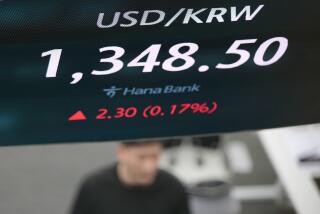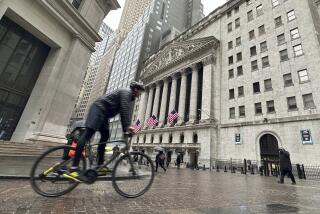Dow closes above 16,000
The Dow Jones industrial average closed above 16,000 for the first time, a testament to investors’ hope that the plodding economy can gain momentum in the coming year.
The index, a gauge of 30 of the largest American companies, jumped more than 109 points to close at 16,009.99. Thursday’s advance was propelled by a better-than-expected drop in jobless claims and a Senate panel’s vote supporting Janet Yellen’s bid to lead the Federal Reserve.
The stock market is caught up in its most furious rally in a decade. The Dow notched its 40th record high this year. It has jumped 22% since Jan 1.
The Standard & Poor’s 500 index is up nearly 26%. And the technology-laden Nasdaq composite index has bounded 31.5%.
“It doesn’t get any better than this,” said Quincy Krosby, market strategist at Prudential Financial. “It’s been a fantastic year.”
Eclipsing the 16,000 milestone underscores the dramatic recovery in share prices from their low in March 2009 after the global financial crisis.
It also highlights the tremendous gains enjoyed by Americans who hold financial assets — primarily stocks and real estate — even as vast swaths of society grapple with high unemployment and measly wage gains.
The market rally has been stoked by the Fed’s economic-stimulus campaign.
The central bank is buying $85 billion a month in Treasury and mortgage securities. That helps keep interest rates low, which encourages borrowing by individuals and businesses.
The easy-money policy has hoisted corporate profits and reinvigorated the housing market.
It also has sent hordes of investors into the stock market in search of returns that are unavailable on low-yielding bonds and bank accounts.
The intensity of the stock rally, however, has stirred concern that investors may be getting ahead of themselves, particularly individuals who have rushed into stocks in the last several weeks.
Optimists say small investors are moving cautiously into the stock market after several years of shunning equities.
“People are being prudent and being smart about how they’re getting into the market overall,” said J.J. Kinahan, chief strategist at TD Ameritrade in Chicago. “It’s not ‘I have to get in and I’m all in,’ which is one of the mistakes we’ve seen in the past.”
However, others fear that stocks are — in Wall Street parlance — melting up.
Some on Wall Street are fretting over the recent enthusiasm of small investors, who have poured money into stock mutual funds. Individuals historically barrel into the market at the tail end of rallies. They miss most of the gains but leave themselves exposed to losses when an eventual downturn hits.
The most immediate threat to the market is the expectation that the central bank will begin to reduce its bond buying sometime next year.
The market tumbled in the spring when the Fed hinted at a so-called tapering. The central bank backed off when the economy cooled in the second half of the year.
It’s now widely assumed that the tapering will start in the first half of 2014. And the chances of that are boosted by recent strong economic reports.
On Thursday, the Labor Department reported that the number of workers filing new unemployment claims fell for the fourth time in five weeks, to 323,000 for the week that ended Saturday. The drop, from 344,000 the prior week, brought the number to its lowest level since late September.
The start of 2014 will also be crucial for the market once companies begin to issue fourth-quarter earnings reports. Investors have been somewhat nonplused during the last half as companies have reported less-than-spectacular results.
Earnings surged in 2010 and 2011 as the economy gained steam. But profit growth has throttled back since then.
Hamilton reported from Los Angeles and Tangel from New York.
Times staff writer Don Lee in Washington contributed to this report.






